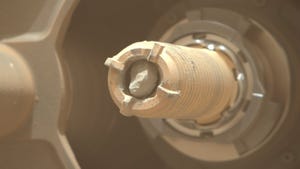This story is part of Welcome to Mars, our series exploring the red planet.
There’s a growing sense of excitement around NASA’s future Mars Sample Return mission, an effort to bring the Perseverance rover’s rock collection back to Earth. A new rock sample is adding to the anticipation because it might contain evidence of ancient water and (fingers crossed) long-ago microbial life — if it existed there.
The rock in question is now Perseverance’s 15th core sample. It’s named “Kukaklek” after a lake and river in Alaska. On Wednesday, the Perseverance team trumpeted the successful collection of the “nice piece of sandstone.”
My collection is growing!
I’ve now got my 15th rock core: a nice piece of sandstone.
Up next, I’m heading back to a nearby dune to break out a new tool – my regolith collection bit – for gathering loose, sandy material. #SamplingMars continues… pic.twitter.com/RkYYpSAoUE
— NASA’s Perseverance Mars Rover (@NASAPersevere) November 30, 2022
Astrobiologist Erin Gibbons of McGill University offered more details on the rock in a rover update this week. Gibbons pointed out a set of thin, white veins visible in the sandstone after the rover abraded the surface away to get a look underneath. The veins are evidence of past water activity that filled small factures with mineral deposits.
NASA had previously talked up the sandstone rock prior to the rover gathering a sample, expressing hope that it might hold biosignatures, which the agency defines as “any characteristic, element, molecule, substance, or feature that can serve as evidence for ancient life.” Gibbons’ update highlights an even more specific dream of perhaps finding water hidden within.
NASA picked the Jezero Crater as the Perseverance rover’s landing site due to its intriguing history of water. It appears to be home to an ancient lake bed and river delta from a time long ago when Mars was wetter.
The rock was part of an outcrop named Hidden Harbor that likely formed back when Jezero was a lake. “This was an exciting find because the veins are strikingly different than the sedimentary rock surrounding them, suggesting that they formed at a different time and under different conditions,” said Gibbons. It’s like cracking open a tiny window into the Martian past.
The veins could hold hidden clues to Mars’ history of microbial life, if it was ever in residence there. “It is even possible that, during crystallization, the minerals in the veins trapped a droplet or two of the ancient water that carried them through the network of fractures in the first place, providing a time capsule of Mars’ watery past,” said Gibbons.
Miniscule fluid inclusions have been found in ancient Earth rocks. A study earlier this year described the discovery of microorganisms 830 million years old in fluid inclusions in halite crystals, raising the possibility that a similar find from Mars could preserve organic matter. “Do the veins in Jezero contain such fluid inclusions? It’s possible, but we cannot know for certain until we bring a sample back to Earth for detailed analysis,” Gibbons wrote.
The Mars Sample Return mission will be complicated and challenging, but necessary to truly understand Mars’ past and, hopefully, answer the question of whether the red planet was once home to microbial life.
NASA Hopes Mars Rock Sample Might Contain Droplet of Ancient Water – CNET
Source: Media Star Philippines




0 Comments